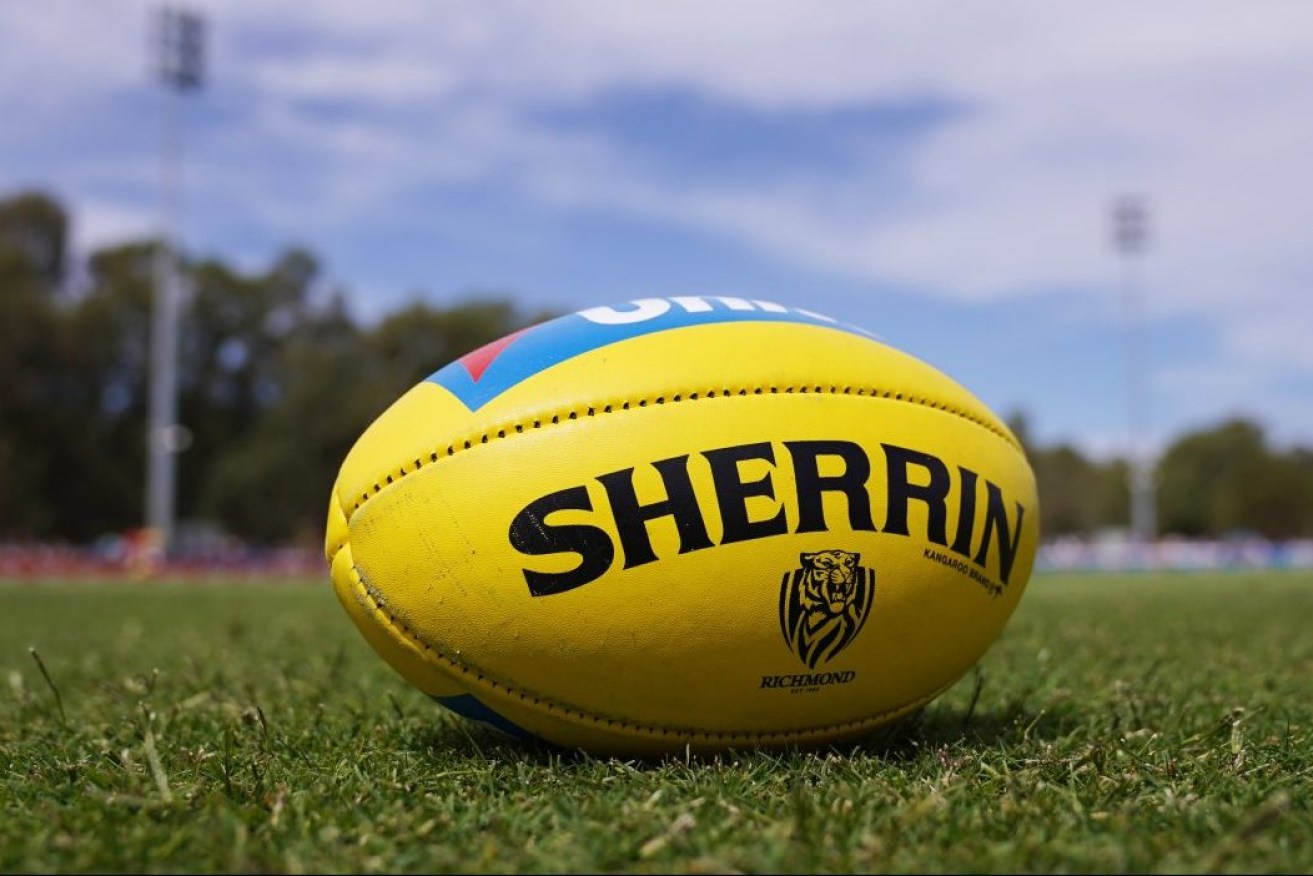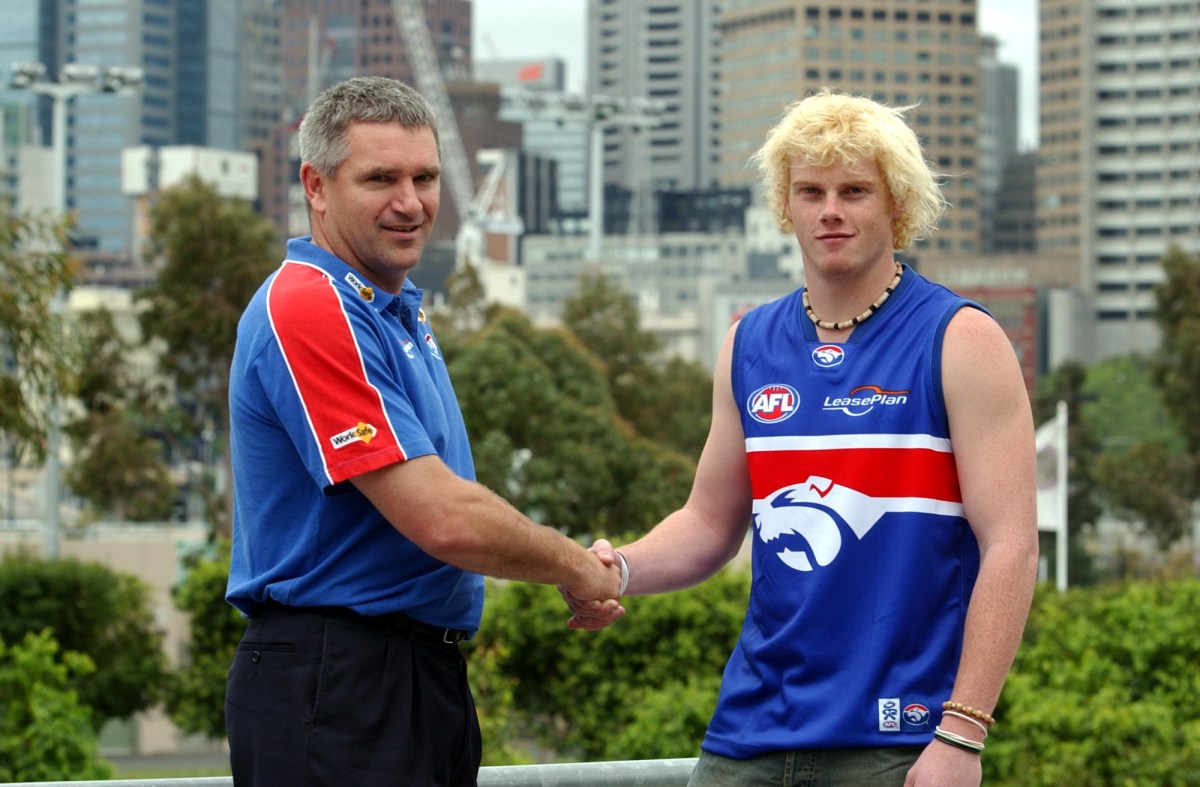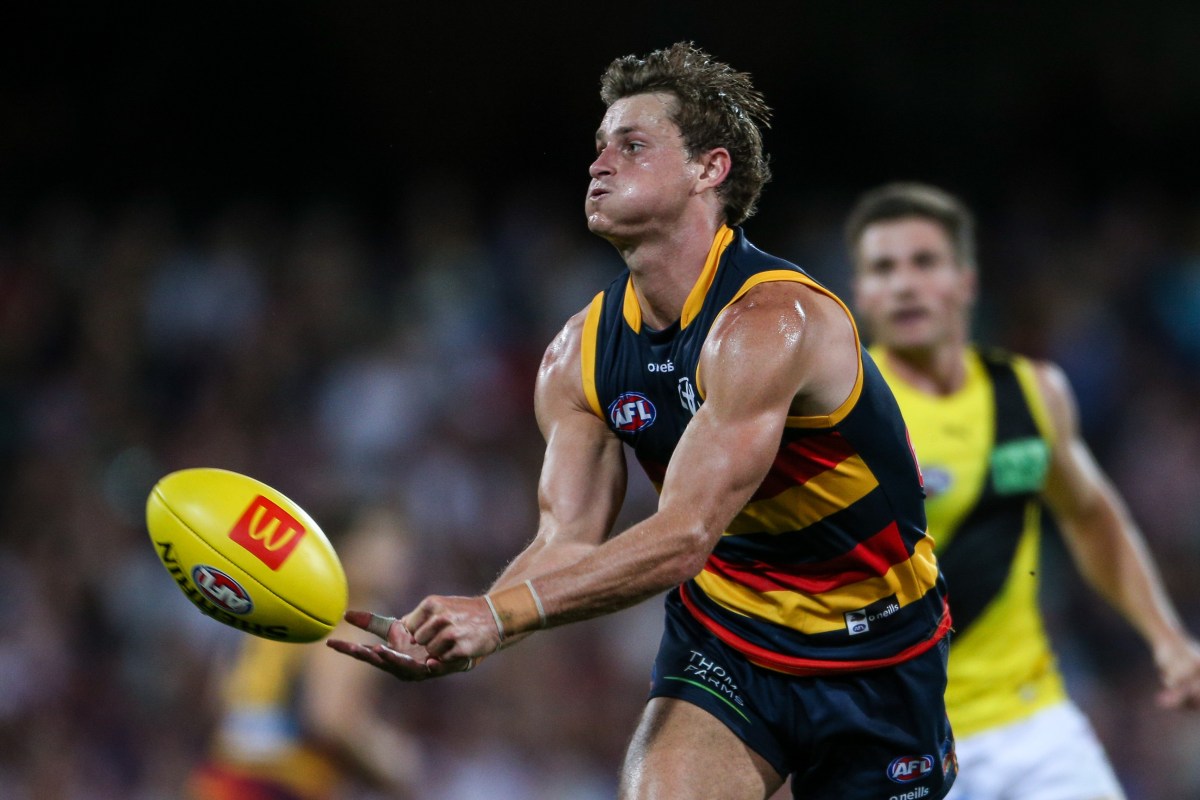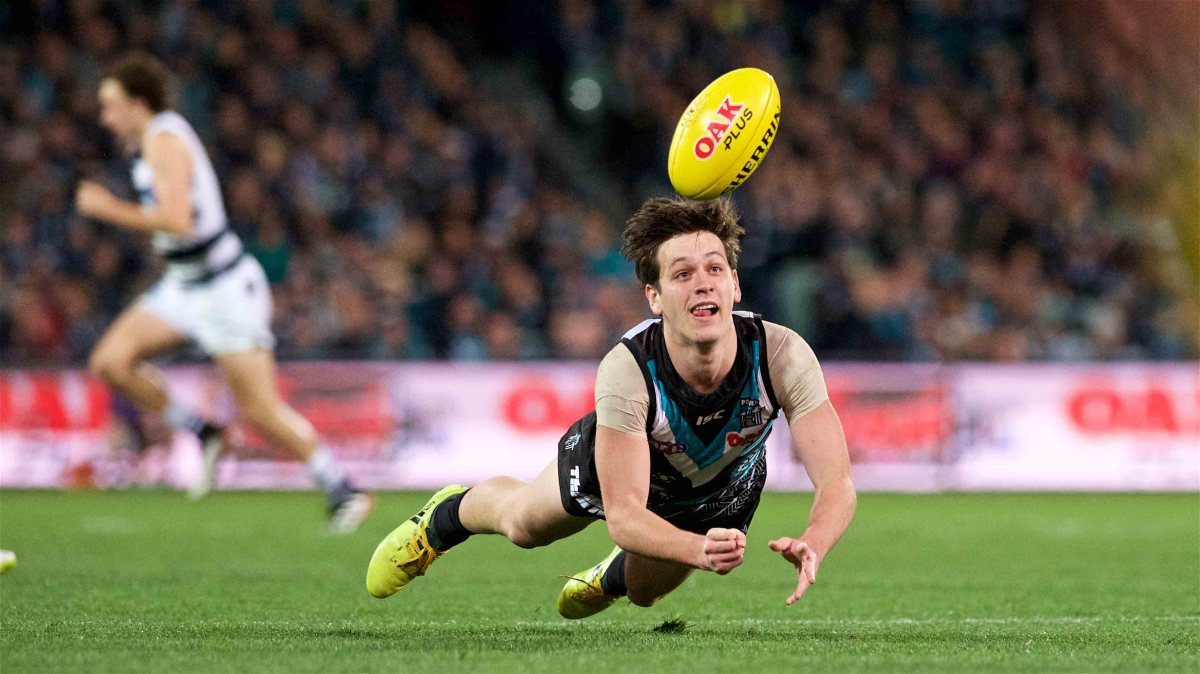When list manager is the AFL’s most important job
It’s known as the “silly season” or “meat market”, when 18 AFL clubs trade draft picks and players to build new hope for a new football season. It’s also a time when one club official becomes the most important person in the game, writes Michelangelo Rucci.

Photo: AAP/Michael Dodge
If any good came to Australian football from the COVID pandemic, it was the stalling of television cameras intruding more and more inside AFL clubs, smashing the mystique.
Sometimes it’s more powerful to keep the fans guessing how it all works, rather than knowing every detail.
Amazon, Paramount, Stan, even Fox Footy would have eventually produced the appealing, multi-episode series titled, “The List Manager” – following the men at the 18 AFL clubs who in the past decade have become more important and powerful than senior coaches in building player squads and the hopes of fan bases around the league.
“List managers, they are more and more important,” says Peter Rohde, who has lived the game as an AFL player, an AFL coach and SANFL premiership coach and as Port Adelaide’s football manager. Today, he is a player agent dealing with list managers wanting to re-contract his clients or lure them to new clubs.

Peter Rohde in 2003 as Western Bulldogs coach, welcoming top recruit Adam Cooney after the 2003 National AFL Draft . Photo: AAP/Joe Castro
“Their importance is in their independence, and they must stay independent,” adds Rohde of list managers and their need to avoid sentiment in the deciding a player’s future. Rohde notes the danger every AFL club faces when a dominating senior coach has the greatest influence on recruiting and re-signing of players. This can put list management on the path to long-term pain.
“I would tell coaches (when working in the AFL system at Port Adelaide and the Western Bulldogs) that you are there to coach players – and coach them until they are no longer here. That decision on when a player moves on is not for the coach.”
It is for the list management team.
Former Crows and Brisbane football chief David Noble notes: “The list manager has to build a strategy that shapes the squad two or three years in advance – and he has to be able to have the coach see that vision of the future as much as the week-to-week needs of a team.”
Stan in March released “Show Me The Money“, a real-life documentary – inspired by the 1996 Hollywood script for Tom Cruise as player manager Jerry Maguire – showing leading AFL players agents dealing with the contracts, trades and exits of AFL players. But, even if some of these player managers such as Paul Connors and Colin Young would prefer to think otherwise, the real power in deciding the fortunes of an AFL team is with the list manager.
It certainly is not the senior coach anymore, and usually for good reason, particularly when a coach’s self-interest to protect his win-loss record or short-term goal to stay in the job with a new contract can undermine the club’s long-term needs. Geelong premiership mentor Chris Scott made very clear earlier this year when challenged on the way his team has been shaped that as senior coach “I am just one vote (of four) in list-management meetings.”
Rohde notes: “It is always tough at an AFL club when the senior coach has the most power. The list manager is there to balance the club’s long-term needs against short-term goals. The coach rarely takes the long-term view.”
The list manager also has just one vote, but more influence with his say on player contracts, a club’s use of the mandated salary cap, drafting of young talent, trading for mature-age players and trading of draft picks.
“The most-important role of the list manager? Don’t stuff up the salary cap,” says Rohde, referring to the $13 million a club can spend each season on player salaries.
At Adelaide, the list manager is Justin Reid, son of former Crows football boss John Reid. He has been at Adelaide since December 2014 after leaving his long tenure as a player agent. His resume at West Lakes includes having built a list by “organic growth” to play in an AFL grand final (but lost in 2017).
His challenge is to successfully complete a rebuild that many still question, particularly when it took Adelaide from grand finalist to wooden spoon within three years. His work does bring much debate among Crows fans – and this heat is repeatedly shared with board member Mark Ricciuto, the leader of Adelaide’s list-management team.
At Port Adelaide, it’s Jason Cripps, the former St Kilda player (60 AFL games) who joined Port Adelaide as an assistant coach to Mark Williams in 2007 and moved into the club’s list manager role in 2011. The stress of holding the hopes and fortunes of a professional sporting team were noted in 2015 when Cripps – while in Perth with the Port Adelaide recruiting staff at the national under-18 football championships – suffered a heart attack while jogging.
“There is a lot of pressure on these guys,” says Rodhe.
Adds Noble, recalling his list-management role at Adelaide before moving to Brisbane as football chief: “I didn’t sleep for the two or three weeks of the trade period (each October).
“I wouldn’t say it is as stressful as coaching or even assistant coaching,” said Noble who was senior coach at North Melbourne during the past two years. “But at this time of the year, it does become stressful as the list manager. You have spent the year preparing for these trade and draft periods and you have a clear plan on how to work both. The key is not to be put off by a last-minute deal that looks good, but is not. And that is becoming harder when you have live trading for picks and soon we will have the same with salary caps.
“The real challenge in list management today is developing clear strategic thinking. And then, after you put a plan down, something new is thrown at you – like live trading of draft picks or bidding for father-son picks. We do seem to like making this game more complicated.”
The “pecking order” at any AFL club is always fascinating.
At the start of the season, the impression is the fitness coach is the most important man on staff. If a squad is not properly prepared during the summer, there is no catch-up opportunity during the season.
At the end of the season, leading to the trade period in October and the national drafts in November-December, it is the list manager with his recruiting team. At Adelaide, Reid’s man is Hamish Ogilvie. At Port Adelaide, Geoff Parker is left with the draft picks Cripps does not trade away to achieve Port Adelaide’s mission to sign midfielder Josh Dunkley from the Western Bulldogs, specialist forwards Junior Willie Rioli (West Coast) and Francis Evans (Geelong) and possibly defender Aaron Francis from Essendon.
But the reality is the list manager is important all-year round.
“I’d put the list manager among the top-three people in your club’s administration,” says Noble. “General manager, coach and list manager. They are the three.
“The list manager has gone well beyond managing contracts with the football manager. And one of his most important roles today is building relationships with player managers, regardless of what you might think of the agents and their part in our game. The list manager has to be able to show the player agents where a club is at, where it is going and what is offer to any player who is thinking of a change of clubs. And there is managing the salary cap.”
Former Crows and Collingwood recruiting master Matt Rendell took InDaily through the annual list-management cycle at an AFL club. The agenda is set in early February each year.
“The recruiters and the list manager sit down,” said Rendell. “They will have a board with every player from every club with his contractual status on the board. As a player re-signs or is re-contracted, that detail gets put on the board. You know the status of every player at every club.
“Then you look at your own list. You ask, ‘Where are our holes? Who is vulnerable on our list? Do we have too much of one type of player? Who is not going well enough? Who is in the last year of their contract?’
“Then you go to the player managers. They will tell you if their clients are vulnerable to be left uncontracted or delisted at their current clubs. They will say if a player wants to leave. Usually, it is about finding more opportunity at another club.
“There are free agents now (players who have given at least eight years’ service to a club and can opt to take a free pass to a rival club, as Karl Amon is doing from Port Adelaide to Hawthorn). You will know about the free agents two years’ out (as Adelaide did with Eddie Betts at Carlton). You can start on a free agent even earlier than other uncontracted players.
“Then, after you have all this information, it is back to list management meetings. ‘What do we need?’ ‘We have these holes’. You pick your targets.
“Then the list manager will go back to the manager, say we are interested in Player X and make an offer. Then the manager and Player X need to go back to their current club. The initial talks are with the list manager of the club and Player X’s manager. The big question is, ‘How are you going to get this deal done?’”
Port Adelaide certainly faces this question with Dunkley, who was left stranded in the 2020 trade period when Essendon failed to secure a deal while the Western Bulldogs insisted on two first-round draft picks for the then 25-year-old midfielder who was still on contract until this season.
This time, Dunkley is out of contract, will probably cost Port Adelaide its first-round draft pick and needs to be reassured Port Adelaide can do the trade. Otherwise, his back-up plan is to try Brisbane.
“What are you going to offer up? That is what the player and his manager need to know,” adds Rendell. “There is the contract – length and money. But the big question is, ‘How are you going to get the deal done?’
“The next bit is the manager and the player going to the club to say they want out. That never happens before a season ends. Phil Davis did tell Adelaide his decision to move to Greater Western Sydney three games out, but he was not playing the rest of the year by injury (to a shoulder) so it was easier for him to clear his locker before the season ended.
“Soon as the player declares, negotiations happen. Now, it is the list manager going to the other club’s list manager saying, ‘This is what we want for Player X’. Usually, the two list managers are poles apart on a player’s worth at the trade table.”
List managers came in vogue at AFL clubs a decade ago, primarily to give an extra layer of protection to recruiting managers against powerful AFL senior coaches.
“Recruiting managers were the original list managers,” Rendell said. “When I was at the Crows, I was technically the list manager while recruiting manager, and (football manager) John Reid did the negotiations with the players on contracts. I did all the homework.
“Derek Hine at Collingwood does all the work as recruiting manager and Graham Wright does the contracts. The list manager/recruiting manager will do the easier, lesser contracts. The footy manager will do the big ones.
“By the late part of the 2000s decade or early part of the 2010s, clubs were moving to having two people work on building and managing. List manager and recruiting manager. They thought that it was all too much for just the recruiting manager. Some people have proven that is a lie – like Kinnear Beatson at Sydney. Stephen Wells at Geelong is probably the first to take on list management with a recruiting team answering to him. Derek Hines has paired with (football manager) Graham Wright at Collingwood. Adrian Dodoro has been the man for a long time at Essendon. They are doing exactly what was happening in my time at the Crows.”
AFL clubs today put four men in a room to deal with list management. There is the list manager, the recruiting manager, the senior coach and the football chief.
At Adelaide, this would be Reid, Ogilvie, Matthew Nicks and Adam Kelly. At Port Adelaide, it is Cripps, Parker, Ken Hinkley and Chris Davies.
For Stan, Amazon Prime, Paramount or Fox, a series on these list-management groups would be football’s version of English writer Jerome K. Jerome’s 1889 classic, Three Men in a Boat (To Say Nothing of the Dog).
Who sets the path? Who steers the boat? Who gets the final say if there is a 2-2 deadlock in the votes or a debate on the value of a potential recruit?
“I would have the final say remain with the club chief executive,” Rodhe said. “Not the board, where a coach can have a major influence on the directors. It needs to be the chief executive making the final call and explaining it to the board.”
So where are the Crows and Port Adelaide positioned for this year’s trade and draft period?
Adelaide has won the battle against Essendon to lure home from the Gold Coast the 2018 No. 3 pick Izaak Rankine, who refused to meet with Port Adelaide. The Crows also have to decide on how to work the last year of 2017 club champion Matt Crouch, the 2017 All-Australian midfielder who was once seen as a captain-in-waiting at Adelaide.
To score Rankine from a smarting Gold Coast, Adelaide will need to work its No. 5 draft pick into the trade – and hope Crouch offers the trump card by seeking a new club.
“Matt Crouch, it is a really interesting situation for him and the Crows,” says Rendell. “They have virtually told him they are not going to pick him and he has a year to go on his contract. If he cannot find a home, what do they do? Delist him? They would have to pay him out. They have the money. They are going to need to pay him out. Why he would want to stay?”

Matt Crouch. Photo: AAP/Matt Turner
Port Adelaide has Dunkley, Rioli and Evans on its trade list. Such a “refit” or “reset” as they call it at Alberton – where there is fear of a fan backlash and a return to the “tarps era” of playing in an empty home stadium should the club “bottom out” as Adelaide has done – rekindles the memories of the 2016 trade period.
Port Adelaide claimed free agents Steven Motlop from Geelong and Tom Rockliff from Brisbane and traded with Melbourne for No. 1 draftee Jack Watts, giving up draft pick No. 31 that allowed Melbourne to recruit livewire forward Bailey Fritsch.
Port Adelaide still went to the draft with four picks – ruckman Sam Hayes at No. 47, midfielder Kane Farrell at No. 51, the untried and unlucky by injury Jake Patmore at No. 58 and former Melbourne midfielder Dom Barry at No. 61.
None of Rockliff, Watts or Motlop will be at Port Adelaide next season when the club will mark 19 years without a premiership. Patmore and Barry have been delisted. Hayes could be traded next month. Farrell this year made his comeback from a serious knee injury and has been trialled as a half-back flanker after making an early impression as a long-kicking wingman.

Zak Butters. Photo: Michael Errey/InDaily
Port Adelaide has in recent years worked the AFL national draft while Cripps has aimed to build the best under-24 squad in the national league.
Since the 2016 refit with Watts, Motlop and Rockliff, Port Adelaide has drafted with success by calling Connor Rozee at No. 6, Zak Butters at No. 12 and Xavier Duursma at No. 18 in the 2018 national draft, forward Mitch Georgiades at No. 18 in 2019 and claiming Lachie Jones along with Jase Burgoyne and Jackson Mead as academy or father-son picks.
It has untried trio Ollie Lord, Jake Pasini and ruckman Dante Visentini to make their mark next season and beyond.
Port Adelaide senior coach Ken Hinkley describes his club’s list-management theme as “we are a ‘draft team’.”
“We bring in young talent. We want to maximise the young talent as best we can. That is the best solution – draft and develop your own,” Hinkley said. “But we are not foolish enough to say, ‘If there is a good player available we are not going to be in the market trying to talk to them’.
“We are balanced with our list management, as we are every year. We would like nothing better than to bring in young talent. But we also want to bring in mature-age talent that can help us immediately.
“We need to look in small forward area with Robbie Gray, Steven Motlop gone; Zak Butters and Connor Rozee moving to the midfield and Orazio Fantasia not being available this year with injury. We were really thin in that area this year. We are in that market (with Francis Evans from Geelong).
“Everyone is always in the key position market. It is what makes and breaks you sometimes. From a young player development, we have (key position options) Jake Pasini and Ollie Lord. We have some development in those key roles, but that does not mean we will not take someone in if they can help us.
“We have Rob (Gray) moving out of the midfield and out of the club. We have Travis Boak at 34. If we can support and buffer into our midfield more, we would love to do that as well (with Dunkley).”
Port Adelaide currently has draft picks Nos. 8, 52 and 56 – and future picks from 2023’s draft – to offer the Western Bulldogs, West Coast and Geelong. It also will get a second-round draft pick, probably No. 26, for losing wingman Karl Amon to Hawthorn as a free agent.
“No. 26 will get (William) Rioli, it’s not too high,” said Rendell of the 27-year-old West Coast forward who has kicked 60 goals in 51 games since 2018 – and was banned for two years (2020 and 2021) for tampering with a urine sample wanted for drug testing.
“His best is great. He is a gun. I am happy to do that trade. It solves a bad need in the Port Adelaide forward line. He can cause havoc. Him and Fantasia as a combination would be extremely dangerous. But he needs to turn up at Port Adelaide in peak fitness.”
As list manager at Port Adelaide, Cripps would hope so.




